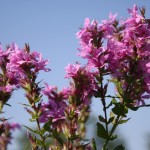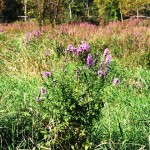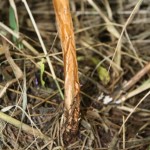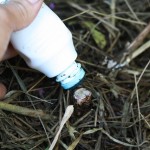The purple/pink blossoming spikes of Purple Loosestrife (Lythrum salicaria) are so beautiful this time of year that I wish this plant could be native to our area. Those responsible for its intentional introduction felt the same way. In Europe and Asia, purple loosestrife’s native homeland, specialized insects and disease control its spread. But purple loosestrife is not a native plant to North America and thus there are no native predators to keep this plant from invading and damaging our wetland areas. Biological control of purple loosestrife has been used with great success in some locations as detailed in this article from the Minnesota DNR and Dept. of Ag: http://www.dnr.state.mn.us/invasives/aquaticplants/purpleloosestrife/biocontrol.html
Biological control can be a wonderful tool in the tool box to control non-native invasive plant species but it will always have some level of disadvantage. It takes time for those little leaf-eating beetles to get established in your growing patch of purple loosestrife. The word “control” infers control, not eradication. It’s been indicated to me that I have a controlling personality. I think “eradicating personality” would be more accurate. If resources permit, I want purple loosestrife and other non-native invasive plants eradicated from my property. This may be unrealistic in some cases but I can’t hit the moon if I’m shooting for the top of the old oak tree. Please read on if you have an eradicating personality. Here is my step-by-step guide to getting rid of non-native purple loosestrife.
Step 1. Correct plant ID
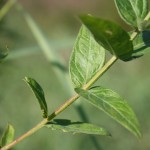
Correctly ID purple loosestrife by its blossome and these opposite leaves. Copyright 2012 Landscape Restoration, Inc.
It’s important to correctly ID any plant before you begin your “eradication” effort. Note the appearance of the plant and blossom in the photos above and the leaves opposite each other on either side of the stem.
Step 2. Find the stem base
I flatten down the grasses immediately surrounding the stem for better access to the base of the purple loosestrife stem. Cutting the stem close to ground level will allow the follow on herbicide treatment to be most effective.
Use a sharp hand pruner to cut the fibrous purple loosestrife stem just above ground level.
Step 4. Apply herbicide to the freshly cut stump
This is my favorite part – permanently doing away with this non-native invase plant. I use the Buckthorn Blaster herbicide applicator to apply herbicide to freshly cut purple loosestrife stems. The herbicide is the same as for cut stump treatment of buckthorn – 18-20% glyphosate* (aka RoundUp Concentrate Plus). I always include blue indicator dye when filling my Buckthorn Blaster with herbicide. It makes it so much easier for me to tell which stumps have been treated.
* If you are near water, use an aquatic from of glyphosate such as the brand name Rodeo.
Write a reply to this blog if you have questions related to cut-stem treatment of purple loosestrife, or would like to share your ideas for controlling invasive species.
Until next time, get outside and go native.


